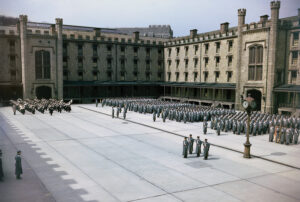The need to improve living conditions and to keep the POWs busy gave the Civil Intelligence and Education staff plenty to do on Koje-do. Gen. Douglas MacArthur believed that only an ideological campaign that fused democracy, capitalism, and evangelical Christianity could stop Communism in Asia. The indoctrination program became the UN Command’s principal opportunity for prisoner reeducation. Begun with 500 Korean POWs at Yongdungpo, an industrial suburb of Seoul, in October 1950, the indoctrination program combined literacy education (in Korean and Chinese), vocational training, recreational sports and physical education, musical events, and political indoctrination.
The reeducation program began in March 1951 with North Korean civilian internees, refugees from Communism who were expected to become interpreters and camp service workers. The screening immediately took on a religious dimension since the refugees included an estimated 1,000 ministers and 20,000 lay leaders, predominantly Presbyterians and Methodists. The U.S. Army and CI&E civilians found it difficult to sort out the self-proclaimed Christians among the POWs, but Korean Christians in CI&E’s employ could do a more dependable job of testing POWs’ religious convictions.
Indoctrination program participants-estimated at 150,000 POWs and internees in 1951-were trained as metalworkers, brick makers, furniture makers, instructors, textile workers (mats and rice bags), tailors, electricians, musicians, and artists. The indoctrination and industrial program participants became so industrious that Far East Command’s civil affairs administrators feared that Koje-do’s captives were taking work away from the refugees and mainland Koreans. In secret, the POWs also made hand weapons.
Given the separation of church and state in the United States, Far East Command could hardly publicize the indoctrination program’s evangelical character. The Far East Command’s reports provided statistics aplenty on all of the indoctrination program’s literacy, civic education, and vocational training efforts, but they never mentioned that an estimated 60,000 POWs and civilian internees “accepted Christ.”
Communist Chinese and North Korean political leaders fully appreciated that Christianity represented a more serious ideological challenge than the vague promises of Western democracy and capitalism. In broadcasts and publications of the Chinese People’s Committee on World Peace, in speeches at the Panmunjo?m negotiations, and through sympathetic journalists Winnington and Burchett, they repeatedly attacked the indoctrination program staff as religious fanatics, dupes, fellow travelers with the Chinese Guomintang fascists on Formosa, and capitalist agents.
The Far East Command’s pursuit of North Korean and Chinese war criminals also spurred the Communist POW resistance movement. By August 1950, the bodies of executed GIs and a handful of massacre survivors proved that the North Koreans were flouting the Geneva Convention on POW treatment. Evidence of repeated, large-scale massacres mounted in October 1950 as the United Nations forces advanced to Seoul and then into North Korea. That month the North Koreans killed 138 Americans in one incident near Pyo?ngyang, and they killed South Korean civilians by the thousands at Taejo?n, Chongju, Hamyang, Mokpo, Kwangju, Pyo?ngyang, and Wonsan, where they had been jailed as “enemies of the people.” The Communists also eradicated suspect North Korean civilians as they retreated north.
The number of incidents and the horrific evidence of mass burials required a quick response, so in October 1950, General MacArthur directed the Eighth Army commander, Lt. Gen. Walton H. Walker to organize a War Crimes Division within his Judge Advocate General’s office and collect evidence of POW murders. He intended to prosecute Communist war criminals. Investigators concluded they had evidence of some 400 atrocities among the nearly 2,000 incidents investigated. The lawyers concluded they could try 326 cases and compiled a list of suspects and witnesses.
The investigators, desperate for results, developed a network of informants at Koje-do. No security precautions could disguise that perhaps a thousand or more POWs might be tried as war criminals, based on their own confessions and the testimony of their fellow prisoners. The South Korean investigation teams, aided by POWs, conducted long, painful sessions with suspects and witnesses. The South Korean army lieutenant who supervised the largest number of agents admitted using torture to extract confessions and expose Communists, as well as suspected murderers.
The hard-core Communist POWs-though a fraction of the total Koje-do prison community-had plenty of reasons to disrupt the 1951 camp routine. The first collective violence against camp personnel occurred on June 18 and 19, 1951, when some North Korean officers protested having to dig latrines and garbage pits. When a South Korean guard detail entered Compound 76, the prisoners stoned the guards. Soldiers opened fire, killing three POWs.
More incidents followed: demonstrations within the compounds, work refusals, threats against camp personnel, and some 15 murders of Korean prisoners. In July and August of 1951, the guards killed eight more POWs. On one occasion, the guard force had to rescue 200 POWs from Compound 78, where hard-core Communists had executed three supposed collaborators in a plan to control the compound. Camp administrators noted that the demonstrations and protests followed the first visits of Red Cross inspectors and journalists to Koje-do. The public relations crisis stirred Gen. Matthew B. Ridgway, who replaced MacArthur in April 1951, to order Lt. Gen. James A. Van Fleet, Eighth Army commander, to fix Koje-do-which meant quiet things down there.
In late September, Van Fleet and his staff visited Koje-do and concluded that the physical conditions were adequate but that there were too few guards and they were poorly disciplined. POWs had too much free time and independence, and the indoctrination program instruction was too classroom oriented. Van Fleet sent a new U.S. Army military police battalion to the island, which brought the 8137th Military Police Group up to three battalions and four escort companies.
In December 1951, a battalion of the crack U.S. 23rd Infantry Regiment augmented the guard force. More South Korean army MPs arrived, too. The guard force now numbered 9,000 officers and men, but it was still 40 percent below the force requested by Brig. Gen. Paul F. Yount, commanding general, 2nd Logistics Command. Yount relieved the U.S. Army camp commander and persuaded the South Korean army to find another colonel to lead its guards. Reinforcements, reforms, and reliefs-the traditional military response to a crisis-should have made a difference. They did not.
In July 1951, Sino-Korean allies and the Soviet Union and the United States agreed to discuss an armistice. Neither the Chinese nor the North Koreans liked negotiating but Stalin, providing the munitions and limited air defense for the Chinese and Korean armies, had enough leverage to draw Mao Zedong and Kim Il-sung into negotiations. The Sino-Korean allies also needed some relief from combat.
The Chinese demanded to manage the talks, and the negotiators established a rough agenda. Agenda Item Four would deal with the issue of a prisoner exchange. The South Koreans had screened all but the hard-core Communists and concluded that they could release almost 38,000 civilian detainees, all from South Korea. Indoctrination program leaders confirmed the estimate, reporting (too optimistically) that 98 percent of the Korean civilian internees had become militantly anti-Communist and wanted to remain in South Korea. General Van Fleet endorsed their release, which would have simplified his security problems, but Ridgway, with guidance from Washington, rejected a total release. About 37,000 civilian internees were finally released in November 1951, but thousands remained.
Their anti-Communism now exposed, several thousand internees, most from North Korea, remained behind the wire-essentially as hostages to the truce talks. When General Ridgway issued “Articles Governing United Nations Prisoners of War,” effective November 1, 1951, he stressed that the articles applied to everyone detained by United Nations Command. Any act of violence or noncooperation might be punished-with the death penalty available for mutiny, murder, rape, assaulting a member of the UN Command, and organizing a mutiny.
The Communists had been equally busy turning the POWs to their advantage. They could see that the United Nations Command had difficulty censoring or shaping the reports of Western journalists, not only Communist champions like Winnington and Burchett but also non-American reporters and representatives of American newspapers critical of President Harry Truman’s administration. The North Koreans, very junior partners on the battlefield, wanted to sponsor the POW resistance and increase their influence at the truce talks. They set their ultimate goal as capturing Koje-do and staging a Great Escape, aided by South Korean Communist guerrillas.
The organizational instrument was the Guerrilla Guidance Bureau, an agency of the Korean People’s Army’s political department, directed from Panmunjo?m by its leader, Gen. Nam Il, who was actually a Soviet citizen. His deputy, Gen. Kim Pa, established contact with the Communist POW leaders.
In the autumn and winter of 1951-1952, the Guerrilla Guidance Bureau sent an estimated 280 male and female agents to Koje-do, some to be POWs, others to establish local support units on Koje-do and the mainland. Col. Bae Chul, a Soviet citizen and Red Army officer, managed the infiltration through Pusan.
[continued on next page]




